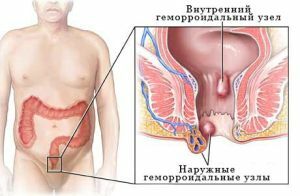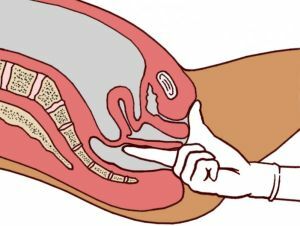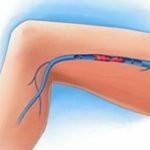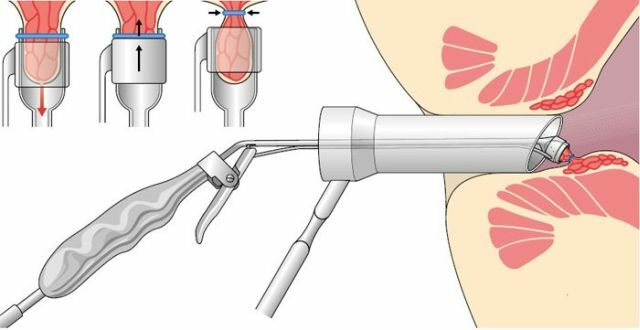 Hemorrhoids are a disease characterized by an expansion of the venous vessels of the rectum, as a result of which three main internal hemorrhoids are formed on the walls of the anal canal.
Hemorrhoids are a disease characterized by an expansion of the venous vessels of the rectum, as a result of which three main internal hemorrhoids are formed on the walls of the anal canal.
External node thrombosis is acute form of chronic hemorrhoids .He arises from the fact that the patient did not turn in time to the hospital for help, because at an early stage the hemorrhoids can be cured quite easily.
Content
- reasons
- disease symptoms and signs of disease
- Classification forms of the disease
- Diagnosis of the disease
- Treatments
- Conservative methods
- method
- Medical Surgery Complications
- disease prevention
- Video: Is it possible to completely cure hemorrhoids?
Causes of the disease
Thrombosis occurs due to the formation of thrombi in the area of the external hemorrhoidal plexus.
As a rule, the causes of its appearance are such factors:
- Strain at defecation - the edema of the fallen hemorrhoids is formed, which is aggravated from a spasm of the sphincter of the rectum. In this case, stagnation of blood in the lower plexus of the rectum is observed.
- Diarrhea - irritation and inflammation of the anus occurs.
- Subcooling .
- Abuse of alcoholic beverages or spicy food - the first contributes to the expansion of the vessels of the gastrointestinal tract, from which accumulation and stagnation of blood occurs;the second factor provokes irritation of the mucous membranes.
- Pregnancy or childbirth - when a fetus is born, the rectum is clamped by a growing uterus, and attempts at labor increase intra-abdominal pressure.
- Lifting of weights, standing work - in the veins there is a delay of blood, the walls of the vessels lose elasticity and symptoms of the disease appear.
- Sitting work - due to stagnation of blood in the small pelvis develops venous insufficiency, the temperature between the body and the seat increases, and a heat compress is created.
- Overloads during sports activities ( weightlifting, cycling, riding).
- Heredity - if the walls of the vessels of the rectum are weakened by themselves.
Symptoms and signs of pathology
The most characteristic symptoms of thrombosis of the external hemorrhoidal node include :
- In the first stages, itching and burning sensation of the anus, there may be a discharge from it.
- Sometimes bleeding occurs during emptying, initially sparse and rare, and then more regular.
- Over time, there is a sharp sudden pain in the anal area, not associated with the process of defecation. It can worsen after diarrhea or constipation.
- There is a dropout of nodes that can not be repaired. After a while they increase, swell and become dark red.
- When the thrombus forms in the node, swelling of the skin in the anus takes place, which over time can cover the entire groin area, causing severe pain.

- Even at rest, with thrombosis, pain does not stop, constipation occurs.
- In the third stage, the inflammation captures an ever larger area, the skin hurts with ordinary touches, not to mention the use of a finger examination of the rectum. On the nodes may begin necrosis, their color becomes purple. In case of delay with treatment, the process of dying out of the skin will progress, which can lead to purulent paraproctitis.
Classification of forms of the disease
External thrombosis of the hemorrhoidal node can be classified according to the following features:
- by severity:
- The first degree of the differs in the small size of the nodes, which respond with soreness during the touch, sensation of itching and burning sensation in the anus. Especially the symptoms are manifested as a result of drinking alcohol, marinades or long sitting.
- The second degree of - swelling of most of the perianal area, hyperemia, spasm of the sphincter, and a sharp pain appears when examining the anus.
- Third degree - swelling captures the entire circumference of the anus, visible crimson internal hemorrhoids protruding from the anus. At the touch, they react with sharp sharp pain. Necrosis may occur, the body temperature may rise, and the defecation process is accompanied by severe pain. Paraproctitis may develop, as well as sepsis( blood infection).
- by species are distinguished:
- internal thrombosis - edema affects internal hemorrhoids;
- external - external plexus injury;
- combined - puffiness of both internal and external nodes is observed.
Diagnosis of the disease
To diagnose with external thrombosis of the hemorrhoidal node, the proctologist should:
- conduct a survey - from which the doctor will find out whether you had had previous hemorrhoid attacks;
- do an examination of the affected area;
- if possible, palpation, but often this is not possible due to severe pain;
- - will appoint a rectoscopy - an instrumental examination of the rectum, which will help to accurately determine the presence of thrombosis. Carried out with an analgesic;
- - will issue a referral for a blood test to determine anemia;
- - will assign an analysis for blood clotting.
Treatment procedures
 If a hemorrhoidal plexus thrombosis is detected, the patient is advised to eliminate physical activity for a while, adhere to a special diet and to remove from his diet acute food and alcohol.
If a hemorrhoidal plexus thrombosis is detected, the patient is advised to eliminate physical activity for a while, adhere to a special diet and to remove from his diet acute food and alcohol.
In general, there are three types of treatment for external thrombosis of the hemorrhoidal node:
- Conservative - helps to eliminate thrombosis in 1 to 1.5 months, after which it is necessary to take preventive measures to avoid relapse. It is carried out at an early stage of chronic hemorrhoids, aimed at eliminating pain and inflammation, improving blood circulation in the rectum, normalizing the digestive process.
- Medication - aims to eliminate the symptoms of the disease and prevent the consequences of thrombosis. It also has an effect in about a month and a half, but relapses are not excluded. To avoid them, you need to abandon the use of alcoholic beverages, eating spicy food, long walks and lifting weights.
- Surgical - is used mainly with the started form of thrombosis, when other types of treatment do not work, and is an extreme measure.
Let us consider in more detail these methods of treating thrombosis of the external hemorrhoidal node.
Conservative methods
For thrombosis of hemorrhoids, it is necessary to adhere to the of such rules:
- compliance with bed rest;
- special diet, whose goal is to prevent constipation - eating vegetables, fruits, bran, abstaining from alcohol and spicy foods;
- intake of laxatives and enema;
- compresses, sedentary baths with the addition of a weak solution of potassium permanganate, which can be replaced with a tincture of chamomile;
- cooling lotions and washings 4 times a day with cool water;
- treatment of the affected area with special ointments, creams, use of suppositories;
- administration of drugs that have antiseptic, analgesic, anti-inflammatory and astringent effect.
 How to identify the symptoms of vein thrombosis in time in the lower extremities and why it is so important to diagnose the disease in time you can find out in our article.
How to identify the symptoms of vein thrombosis in time in the lower extremities and why it is so important to diagnose the disease in time you can find out in our article. To whom is the operation of miniblebectomy appointed and what is the essence and video procedures you can learn by reference.
Drug method
The list of drugs that are often prescribed for hemorrhoidal plexus thrombosis is quite wide. In particular, are applied:
- Heparin ointment, Venobene, Traxevasin, Hepatrombin G - promote the process of resorption of thrombi, relieve inflammation and swelling. A thin layer is applied to the skin and rubbed, or applied to the linen fabric, which is applied to the hemorrhoids. Applied 1-3 times a day.
- Prednisolone is a tablet or suspension for injection that also reduces inflammation and swelling, reducing itching. They are taken strictly according to the prescription of the doctor.
- Polydocanol are injections that have anesthetic effect. Introduce in a dosage of 2 mg per 1 kg of body weight.
- Detralex is applied on 6 tablets twice a day during meals for 4 days, and after - 2 tablets 2 times, for 3 days. The action of the drug is aimed at increasing the tone of the veins.
- Dufalac - promotes the improvement of bowel functions, acts as a laxative. Admission 15 - 30 ml per day.
- Proctoglivenol, Proctosedil - are in the form of ointments, gels or suppositories. As for the latter, they are injected into the rectum 1 to 3 times a day. With inflammation of external nodes it is more convenient to apply ointment. These drugs are aimed at relieving pain and inflammation.
- Levomekol, Levosin - ointments, have an anti-inflammatory effect.
- Posterizan, Relief, Proctosedil - candles with anesthetic effect, which are injected into the rectum twice a day.
- Seated baths with tincture of chamomile, sage, and microclysters.
Surgery
Usually, in the third stage of thrombosis or with acute thrombosis of the external hemorrhoidal node, surgical intervention is used.
There are two types of operations:
- Thromboectomy is an operation to remove a thrombus. Used in the presence of large nodes. It is carried out without hospitalization, under local anesthesia, and gives a quick relief of the patient's condition. As a result of the operation, there remains a wound about 0.5 cm long, which heals 4 days. It is considered the most effective method of treatment of external plexus thrombosis. But there is no guarantee that another knot will not form in the neighboring node. To prevent this, needs to maintain a healthy lifestyle , do not overload your body, do not overwork.
- Hemorrhoidectomy - this operation is prescribed if the exacerbations of hemorrhoids are characterized by increased frequency. The removal of not only the blood clot, but also the node itself is performed.

In the photo, removal of thrombosis of the external hemorrhoidal node with the operation
Complications of the disease
These complications may represent a threat not only to the health of the patient, but also to his life , so it is very important not to let the disease to this stage, but in time to contact the proctologist.
And remember that at the initial stage, getting rid of hemorrhoids is much easier than treating thrombosis.
Prevention
Hemorrhoids need not only treatment, but also in adherence to preventive measures:
- proper nutrition - you need to exclude from the diet the use of alcohol, spicy and spicy food, and pay attention to such useful substances as vegetable fiber, fermented milk products( kefir, sour cream, cream, cheese, cottage cheese);
- hygiene of the anus every time after the defecation process;
- prevention of prolonged immobility, change of positions;
- restriction of physical activities;
- avoidance of hypothermia.
In conclusion, it must be said that your health is completely up to you. Therefore, do not think that such a severe form of hemorrhoids, like thrombosis of external nodes, will pass by itself. It's nothing shameful that you contact a doctor with this illness, no.
But timely treatment will bring you relief and keep your health.
